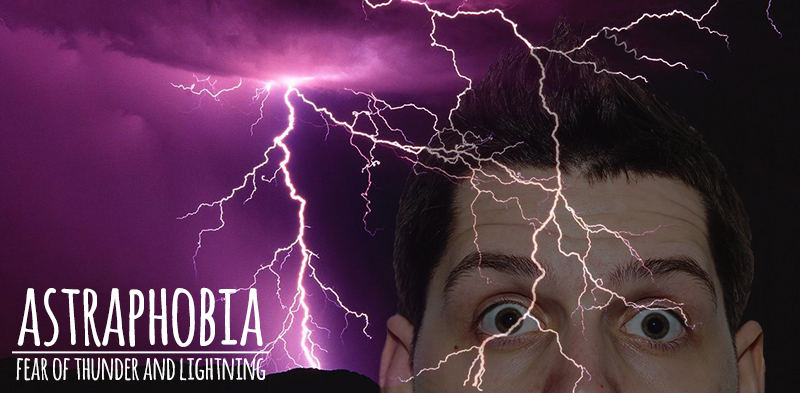Many people love to go outside and watch the rain fall down along with the rumbling thunder and lightning bolts. While the nature’s demeanor might be a matter of pleasure for them, some might secretly hold an unexplainable fear of this thunder weather. Anyone having an intense amount of fear of thunder, lightning and rainstorm may be suffering from astraphobia.
Astraphobia has been derived from Greek word “Astrape” which means lightning. Both human beings and animals might have this kind of unreasonable and overwhelming anxiety of thunder and lightning. Several other names such as astrapophobia, brontophobia, tonitrophobia and keraunophobia also are used to denote this kind of fear.

How Common is Astraphobia?
While a normal startle may be common with a thunderbolt for some, many people might get fearful to the most extreme form. Astraphobia is also a common phobia in people, and can occur with anyone regardless any other personal attributes. However, it is seen very much common in children. In the U.S, it’s estimated that at least 10 percent of people suffer from astraphobia to some extent. In fact, even animals like dogs and cats may have astraphobia and are seen hiding somewhere or trembling during a thunderstorm.
What Causes Astraphobia?
The major cause known to develop astraphobia in people are a traumatic experience related with thunderstorms, rain and lightning. Other factors that contribute in developing this phobia is the in-built personality traits of the person inclined towards fear and anxiety.
A Traumatic Experience
Many people who went for treatment of astraphobia had a previous history of traumatic incident related with thunder, rain and lightning. A person may also get astraphobia if he/she has witnessed a loved one or someone else get hurt by the thunder and lightning. Any such event can be a major cause for astraphobia in people.
Personality traits
People are more vulnerable to develop this phobia if they already have a strong trait associated with fear and anxiety in their personality. Even a small distressful event associated with the thunder and rainstorm might trigger this trait and lead to astraphobia.
What Are The Symptoms of Astraphobia?
The common symptoms that occur with astraphobia which can occur in both children and adults are:
- Intense and constant fear during thunder, rainstorm and lightning
- Distressed and anxious whenever any thunderstorm is anticipated but not really occurring
- Realization that the fear is irrelevant and excessive (except in children)
- Increased alertness and checking weather forecasts before going anywhere outside
- Trying to avoid the weather by any means such as hiding in a closet, covering with blankets or not leaving the house at all
- Clingy behavior towards a loved one and guardians (only in children)
- Panic attacks accompanied by physical signs such as trembling, abdominal pain, trouble in breathing, heart palpitation, chest pain, frequent urination, numbness around limbs, feeling of being out of control, nausea and sweating
When to Visit A Doctor?
If you or your children have shown above symptoms for a time period of more than six months, and have disrupted daily living, you need to visit a doctor. If you have been staying home all the time to avoid storms, missing works and travel trips, you probably need to start with the treatment process for astraphobia. Similarly, if your child has been refusing to go school extensively and showing clingy behavior due to weather, you need to seek help from a doctor.
How is Astraphobia Treated?
A series of therapies and required medicines can help to control the symptoms. Medicines may only be used in severe cases.
Exposure therapy
Exposure therapy is focused on bringing out the fear of the person, and studying it carefully. The therapist makes the person confront with a real thunderstorm if possible, or may be a video or just an audio under a safe environment. The major aim of exposure therapy is to study the level of the fear, and how it actually occurs in the person. Through regular exposure, the therapist tries to bring down this level of fear gradually by using relaxation techniques. The therapist will teach breathing exercises, self-talking and mental visualization exercises to calm down the senses in a fearful situation.
Cognitive Behavioral therapy (CBT)
CBT is a much required therapy alongside exposure therapy. While exposure therapy is totally focused on controlling the fear and panicking, CBT is focused on changing the entire thoughts associated with thunder and lightning in the person. The therapist conducts enclosed one to one counseling sessions to know the negative thoughts surrounding the thunderstorms, and replaces them with positive images. The major goal of this therapy is to modify the thoughts and behavior related with phobia, and helps the person regain a normal life.
Medicines
If the phobia has caused a considerable distress and turmoil in a person, some anti-anxiety and anti-depressant medicines may be prescribed by the doctor. However, they are only opted for serious and severe cases of phobia.